|
The Suite Charm of
Antique Nutcrackers
| By Daniele Gair
Posted December 2011
|
 |
Well into the 21st century, when
shopping for the holidays means standing
in line for the latest TV, video game
console or battery-powered “pet,” the
nutcracker remains the quintessential
Christmas toy. But far from being simply
decorative holiday items, nutcrackers
were once an essential part of life and
have exhibited a fascinating combination
of form and function for thousands of
years. And for many, the tall wooden
soldier so beloved by little Clara in
Tchaikovsky’s famous ballet has
transformed not into a handsome prince,
but into princely collections.
As nuts have been a staple in the
human diet for millennia, it makes sense
that one of the fi rst tools developed
involved cracking them open. When
one’s molars or fi ngers couldn’t do the
job, prehistoric man and woman used
stones. Excavations all over the world,
from the Middle East and Northern
Europe to the southern United States,
have all yielded nut-cracking stones.
These were usually large, fl at stones on
which the nuts would be set, found with
smaller stones that would have been used
for crushing. The larger stones sometimes
even had small, nut-sized indentions on
their surfaces, perfect for holding the
walnut or pecan steady.
Of course, man’s tools got cleverer
and more sophisticated as he did, and
nutcrackers evolved from simple crushers
to instruments that removed the fl esh
from the shell with minimal damage to
the nut itself. Over the centuries, several
types of nutcrackers were developed to
do the job. These include: the percussion
cracker, which would involve a tool with
which to simply crush the nut; the screw
nutcracker; and the ever-popular lever.
In collecting nutcrackers, one is
certainly spoiled for choice. Nutcrackers
have been crafted of a stunning variety
of materials, from wood and metals
to porcelain, ivory and even plastic,
and refl ect the styles of their times and
culture. They were also tools of some
importance and prestige. In fact, there is
evidence of nutcrackers being found in
ancient graves!
Perhaps the most recognizable
and collectible nutcracker is the lever.
Normally consisting of two rods joined
together to form a fulcrum, or pivot point, a lever applied either direct or indirect
pressure on the nut to crack the shell,
depending on which side of the fulcrum
the nut was placed. If placed on the side
of the fulcrum nearest the hand, this was
direct pressure. If placed on the opposite
side, the nut was cracked with indirect
pressure.
Levers are almost certainly the most
popular and oldest type of nutcrackers
still to be found today. Carved initially
of wood, and later made of metals like
cast or wrought iron or silver plate, lever
nutcrackers have been found dating to the
3rd and 4th centuries B.C. These earliest
forms were made of metal, and many
already exhibited incredible artistry.
For instance, one example housed at the
Leavenworth Nutcracker Museum in
Leavenworth, Wash., currently displays
a Roman nutcracker, crafted of bronze
and intricately decorated, that is dated
between 200 B.C. and 200 A.D.
Levers were made of a great variety
of woods, either carved by hand or turned
on a lathe, from nut and fruitwoods to
pine, birch or the favored boxwood,
which gave carvers a fi ne grain and even
color. Some amazing specimens of these
wooden, or treen nutcrackers, carved in
France and England, can be dated to the
16th century and are still in exceptional
condition. Displaying an incredible
array of designs, especially human and
animal fi gures, these crackers show an
amazing amount of detail. And detail was
incredibly important, as craftsmen turned
these commonplace items into works
of art. Those from Europe, particularly
Germany, France, Italy and England,
are of particular interest and value.
Today, many are housed in prestigious
collections around the world, such as the Metropolitan Museum of Art and the Leavenworth Museum.
Levers made of metal, especially cast
or wrought iron, are the most common
nutcrackers to be found and are highly
collectible. Cast iron fi gural crackers,
mostly made in England and the United
States, were quite popular, as a particular
style could be easily reproduced.
These often exude a folksy charm and
can be found in the forms of animals,
particularly squirrels and dogs, and any
number of unique characters.
Crackers of cast brass were also
made in England in the 18th and 19th
centuries. The 19th century also saw
the creation of silver and silver-plate
nutcrackers that were included in fi ne
fl atware services. Crafted by the best
makers of the Victorian Era, these
crackers were also sold individually or in
sets with grape shears or nut picks. These
fashionable items exhibited the greatest
intricacy, which they maintained over the
years.
Many levers were also reversible,
meaning the two arms could be reversed
to accommodate larger or smaller nuts.
This silver pair (pictured), auctioned
at Bonhams for £276, was made by English silversmith
William Bateman
and dates to 1790.
Two similar pairs,
hallmarked 1847
by John & Henry
Lias, brought
£2,000, or $3,904,
at Christie’s in
2008.
A more
compact form of
nutcracker was
the screw, which
fi rst appeared in
the 17th century.
Essentially carved
of wood, these
crackers consisted
of a small cavity
in which a nut was
placed, pierced by
a screw, that when
turned, gradually
added pressure to
the nut to crack
the shell. These
could be simple or
carved in fi gural
shapes, like the
late 18th or early
19th century treen
piece pictured,
probably carved of coquilla nut wood, which takes the
form of Mr. Punch.
Screws were also made of metals,
like levers, such as iron, as well as brass
and silver, and displayed ingenious and
intricate motifs. They were also made of
more precious materials, like this ivory
screw. Ivory was typically considered
to be too soft to withstand the repetitive
cracking and was usually used as an
accent to metal crackers. Those made
completely of ivory are rare, and those in
good condition are even rarer.
Most antique nutcrackers to be found
on the market today will date to the
19th and early 20th centuries, and some real treasures can be found from this
period. It is very rare to fi nd 16th to 18th
century items, but it is possible. Christie’s
auction house has auctioned a number of
crackers dating to this period, including
a northwest European fi gural lever
nutcracker of carved boxwood, circa
1500, which sold for more than $4,400,
and a similar fi gural boxwood lever,
either German or Italian in origin, circa
1572, which brought a price of £10,000,
or $14,720.
Some of the most collectible and
valuable nutcrackers are not antiques at
all. A few companies are renowned for
making the iconic nutcracker style, and
the fi nest are considered to be produced
in the Seiffen region of the Erzebirge
Mountains in Germany. Wilhelm
Füchtner, who is known as the “father
of the nutcracker,” produced the fi rst in
1870 in this very region.
Today, companies like the Steinbach
Company produce some of the most
whimsical and artistically inventive
fi gures on the market. They are among
the most valuable, as many of the styles
have been discontinued after a limited
run. The company’s fi gure of Merlin the
wizard, for example, was introduced in
1991, and made in a run of only 7,500.
A Merlin today can be priced at almost
$4,000.
As with
starting and creating
any collection,
it is important
to decide where
one’s interests lay.
One can collect
nutcrackers by style,
type of material, or
even geographical
region. It is also
crucial to learn to
identify items of
good quality and
those with a bit
a wear and tear,
as condition will
affect value, and to
learn how to care for items made of more fragile materials.
Age can take a toll on even the hardiest
metal if not stored in the right conditions
or cleaned properly.
To fi nd out more about the
fascinating world of nutcrackers, search
your local library or bookstore for some
of the highly informative books on the
subjects, such as The Art & Character
of Nutcrackers by Arlene Wagner,
Ornamental & Figural Nutcrackers by
Judith A. Rittenhouse, and Nutcrackers
by Robert Mills. These books are
wonderful for learning the in-depth
history of nutcrackers, as well as how to
start a collection and how to identify your
fi nds. Also, don’t forget about contacting
online sellers and the Nutcracker
Collector’s Association for expert advice.
In The Nutcracker, the little soldier
is the most treasured gift of all. For those
who value beauty, history and a touch of
whimsy, these enchanting tools can open
up a whole new world.
___________________________
A native New Orleanian, Daniele Gair
has been obsessed with the written
word and the arts ever since she could
remember. Holding a B.A. in English
from Newcomb College of Tulane
University, she has honed her skills as a
professional writer for 13 years. Daniele
has explored the world of visual art as an
owner of an art gallery, and she currently
researches and writes about fi ne art and
antiques for M.S. Rau Antiques in New
Orleans.
|
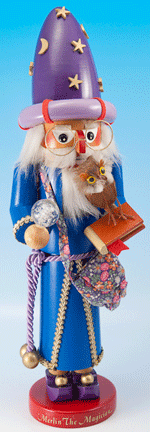
A Merlin nutcracker by the Steinbach
Company, introduced in 1991. (Photo:
Mt Olympus Clock Shop, www.mtolympusclocks.com)
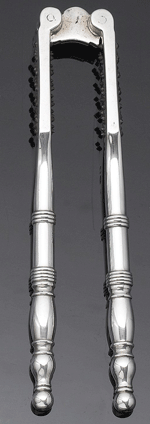
A pair of
George III silver
nutcrackers, by
William Bateman,
London 1790,
5.3 inches in
length; sold for
£276 with bp.
(Photo: Bonhams)
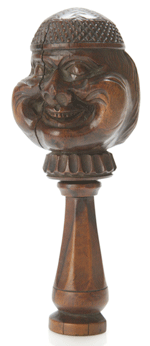
A late 18th or early 19th century treen
(probably coquilla nut) nutcracker
carved in the form of Mr. Punch, 5.5
inches high; sold for £120 including bp.
(Photo: Bonhams)
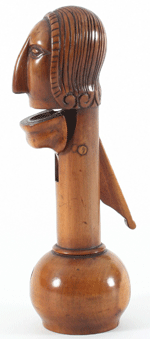
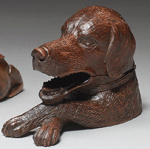
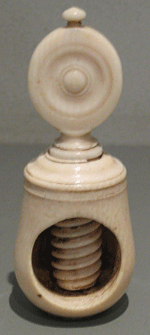
|